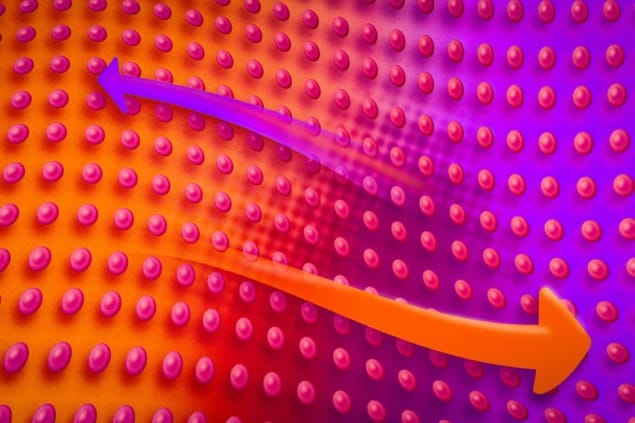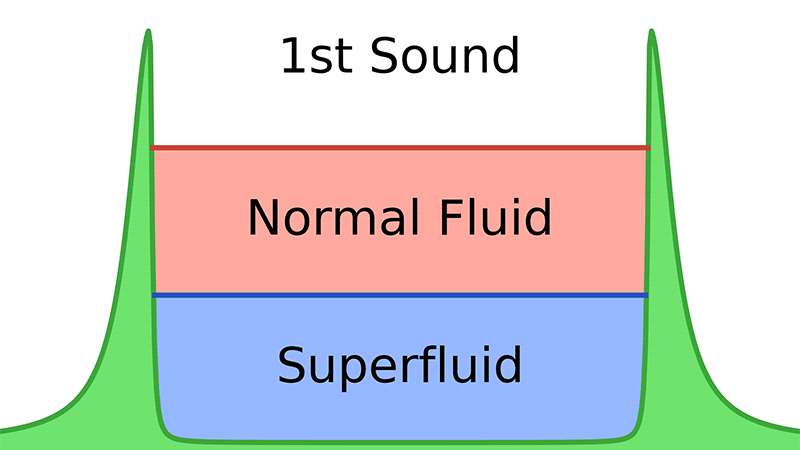
A new technique for monitoring “second sound” – a bizarre type of heat wave that occurs in superfluids – has been developed by physicists in the US. The work could help model a variety of scientifically interesting and poorly understood systems, including high temperature superconductors and neutron stars.
The term “second sound” was coined by the Soviet physicist Lev Landau in the 1940s after his colleague László Tisza suggested that the bizarre properties of liquid helium might be explained by considering it as a mixture of two fluids: a normal fluid and a superfluid that flowed without friction. This arrangement gives rise to the possibility that, if the superfluid and normal fluid flow in opposite directions, the material will not experience any apparent disturbance, but heat will nevertheless pass through it like a wave as the normal fluid and superfluid switch places.
Shortly afterwards, another Soviet physicist, Vasilii Peshkov, confirmed this experimentally. “He [Peshkov] literally was able to heat the superfluid periodically on one side and measure that the heat was distributed like a standing wave in his container,” says Martin Zwierlein, a physicist at the Massachusetts Institute of Technology (MIT) who led the new study.
In the 21st century, physicists such as Zoran Hadzibabic of the University of Cambridge, UK; Deborah Jin of JILA in Boulder, US; and Wolfgang Ketterle of MIT introduced a new dimension to second sound research by demonstrating that Bose–Einstein condensates and strongly interacting Fermi gases also display superfluid properties. In 2013 Rudolf Grimm of the Center for Ultracold Atoms and Quantum Gases in Innsbruck, Austria became the first to observe second sound in such a system. “[Grimm] could not see the heat, but whenever you have a heat gradient in a gas there is also an accompanying density gradient because the gas is compressible,” Zwierlein explains. “There was a travelling density wave at a speed much slower than the speed of normal sound and that was associated with second sound.”
Direct imaging of heat flow
In the new research, Zwierlein and colleagues imaged heat flow in a strongly interacting Fermi gas composed of ultracold lithium-6 atoms. To do this, they placed the atoms in a box potential and switched on a magnetic field precisely tuned to a value associated with a so-called Feshbach resonance in the atoms. At this resonance, fermionic lithium-6 atoms below a certain critical temperature can interact with each other at long range, forming bosonic pairs by a mechanism akin to the Bardeen-Cooper-Schrieffer mechanism in superconductivity. “It’s a bit misleading but helpful for first understanding to think of the superfluid as the component of pairs and the normal component as the component of unpaired atoms,” Zwierlein explains.


Next, the researchers applied a short radiofrequency (RF) pulse to the gas. The RF radiation excited the unpaired atoms to a different hyperfine state, leaving the paired atoms undisturbed. The researchers then used laser light to image the two groups of atoms. “These hyperfine states are split enough that our optical probe responds only to the particular hyperfine states that we selected,” Zwierlein explains. “Where there are lots of atoms, we get a dark shadow; where there are almost no atoms, the light passes through.” Crucially, because colder gases contain a larger fraction of paired atoms that are unaffected by the RF, the images contain information about the gas’ temperature. The researchers could therefore image heat flow directly, even when the medium remained still.
Armed with this new tool, the researchers made several measurements. At the coldest temperatures, locally heating a single region caused strong second sound waves. As the medium approached its critical temperature, these waves became gradually less significant for heat transfer compared with simple diffusion. Above the critical temperature, they vanished altogether. The team also observed anomalous behaviour at the critical temperature. “It’s similar for any phase transition like water boiling in a kettle: you see bubbles – things go crazy,” Zwierlein says. Finally, they measured the damping of the second sound, which arises from the fact that although the superfluid component flows without friction, the normal fluid does not.
High-temperature superconductors and neutron stars
The researchers say the new technique should apply to Bose–Einstein condensates as well, and could also be used for analysing the recently developed Fermi–Hubbard model of high-temperature superconductivity. Moreover, Zwierlein suggests that “matter inside a neutron star is very similar in behaviour, surprisingly, because these neutrons are also very strongly interacting, so we’re learning something from our puff of gas in the lab which is a million times thinner than air something about crazy neutron stars, which are hard to get to.”

‘Second sound’ appears in germanium
Hadzibabic, who was not involved in the study, is impressed. “It’s not just that they do great thermometry below a nanokelvin – which is hard even if the temperature’s the same everywhere – but additionally they can do it locally, which is key for seeing this wave,” he tells Physics World. “So they can say here it’s half a nanokelvin hotter and here, 20 microns away, it’s half a nanokelvin colder.” He says he looks forward to seeing the technique applied “in systems about which we know far less and where the whole system is far from equilibrium”.
The research is published in Science.
- SEO Powered Content & PR Distribution. Get Amplified Today.
- PlatoData.Network Vertical Generative Ai. Empower Yourself. Access Here.
- PlatoAiStream. Web3 Intelligence. Knowledge Amplified. Access Here.
- PlatoESG. Carbon, CleanTech, Energy, Environment, Solar, Waste Management. Access Here.
- PlatoHealth. Biotech and Clinical Trials Intelligence. Access Here.
- Source: https://physicsworld.com/a/physicists-take-the-temperature-of-second-sound/



